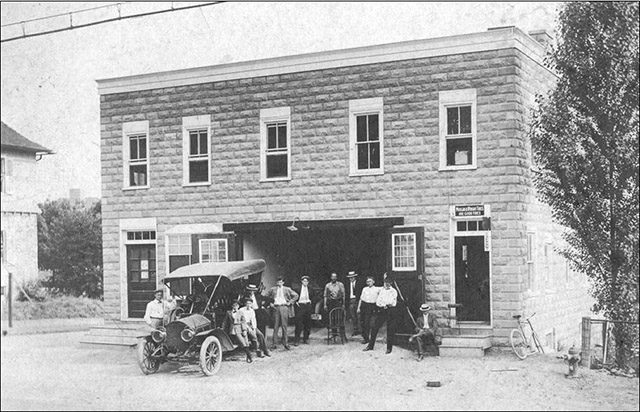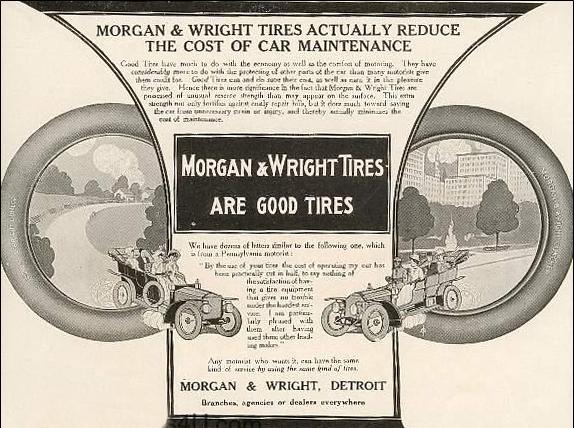|
Home : Quarterly Archives : Volume 44 |
Tredyffrin Easttown Historical Society |
|
Source: Summer 2007 Volume 44 Number 3, Page 115 PURSUING A LOCAL AUTOMOTIVE MYSTERY Among the hundreds of photographs in the image collection of the Tredyffrin Easttown Historical Society is one simply captioned “Herbert Edwards Garage,” shown below. A two-story masonry building confronts the viewer's eye. A wide double-bay garage stall is flanked by pedestrian doors on either side. In the foreground, a 1909 Ford Model T Touring Car is occupied and surrounded by almost a dozen men and boys. A bicycle leans against the building's right side. No other caption information assists in identifying where or when this image was recorded. Recently, society members Mrs. Joyce Post and Mr. Herbert Fry were discussing the origins of this photograph, and they referred to a 1989 article attributed to Mr. Robert Goshorn in the then-called Tredyffrin Easttown History Club Quarterly entitled "The Changing Face of Paoli."
Photographer unknown. Tredyffrin Easttown Historical Society collections. Mrs. Post summarized the article's account of the Edwards Garage: "Several years before the First World War, Ralph Edwards [not Herbert], who had opened the first garage in Berwyn, attempted to open a similar establishment in Paoli in 1911. He soon was confronted with a petition for an injunction barring him from erecting a garage and repair shop for autos,” it being alleged that “it would be offensive and a danger to the neighborhood.” The force behind the petition was the Paoli Improvement Association, formed by John Dingee and Henry Biddle, "who were great horse lovers and violently opposed to automobiles and gasoline-propelled vehicles." One of the provisions of the association prohibited the sale of gasoline or the repair of automobiles on this land. “Because of this opposition, Edwards relocated in Malvern. . . ." Mr. Goshorn's information is useful, but fails to provide definitive answers as to the identity of this image. But perhaps the photograph itself offers at least one more clue. If one looks carefully at the door on the building's right side, one will see above the transom the phrase “Morgan & Wright Tires Are Good Tires.” Can this slogan help to better identify this image? Here is a brief background on Morgan & Wright: The bicycle boom was thriving when, in 1891, Fred Morgan and Rufus Wright founded the Morgan & Wright Bicycle Tire Co. in Chicago. Besides bicycle tires, their company also produced tire-related items (pumps, patch kits, tire repair accessories) and bicycle products (pedal rubbers, rubber toe clips, chain lubricant). By the end of the 19th century, Morgan & Wright had become the world's largest manufacturer of bicycle tires. Their slogan, “Morgan & Wright Tires Are Good Tires,” was widely used to market the firm and their products. With the onset of the 20th century, and the advent of the automobile, the founders foresaw a far greater marketplace evolving. As the need for rubber automobile tires grew dramatically, the company began to introduce them to its existing bicycle product lines. In August 1905, Morgan & Wright began construction of a 900,000 square foot manufacturing building in Detroit in order to be nearer the heart of the infant auto industry. With the completion of their new building in October 1906, the company completed its relocation from Chicago to Detroit. The company's fortunes would thrive for the next several years, but in 1911 the process began in which the United States Rubber and Tire Company acquired Morgan & Wright. US Rubber would later became known as Uniroyal. In the 1989 article referred to above, Goshorn states that prior to 1911 Ralph Edwards opened his first automobile garage in Berwyn. Edwards attempted to open a similar establishment in Paoli, met local resistance, and soon after relocated his new business to Malvern. The acquisition process to subsume Morgan & Wright within the United States Rubber and Tire Company began in 1911. A 1912 supply catalogue states that Morgan & Wright tires would henceforth be marketed as U.S. Rubber tires. This corporate conversion would have also eliminated the famous slogan used in selling the increasingly unavailable Morgan & Wright brand tires.
I have concluded that the subject of the society photograph is the original Ralph Edwards Garage in Berwyn. The time period is 1909 to 1911. As stated, the automobile in the photograph is a 1909 Ford Model T touring car. The M&W slogan above the door, “Morgan & Wright Tires Are Good Tires,” is the same as depicted in the ad shown to the right - from the November, 1907 issue of the popular national periodical Country Life. This famous slogan, accompanied by the copy linking superior tires with good automotive maintenance, demonstrates the connection for any business trying to encourage both service sales and tire sales. This ad provides another clue. At the bottom are the words “Branches, agencies and dealers everywhere.” Because the Morgan & Wright slogan is the only advertising shown on the garage in our photograph, I believe it probable that the Edwards Garage had an agency relationship with Morgan & Wright that would have continued through the transition of the company to U.S. Rubber in 1911. Do our readers have more information on this fascinating image from our past? Sources Robert Goshorn. “The Changing Face of Paoli.” Tredyffrin Easttown History Club Quarterly, Vol. 27 No. 3 (July 1989) pp. 102-112. Vivian M. Baulch and Patricia Zacharias. “Detroit's giant stove and tire.” The Detroit News, December 19, 2002, May 14, 2007, http://info.detnews.com/history/story/index.cfm?id=198&category=life “The MODEL T FORD - The Car that changed the world,” March 2. 2007, May 14, 2007, http://oldcarandtruckpictures.com/ModelTFord |

